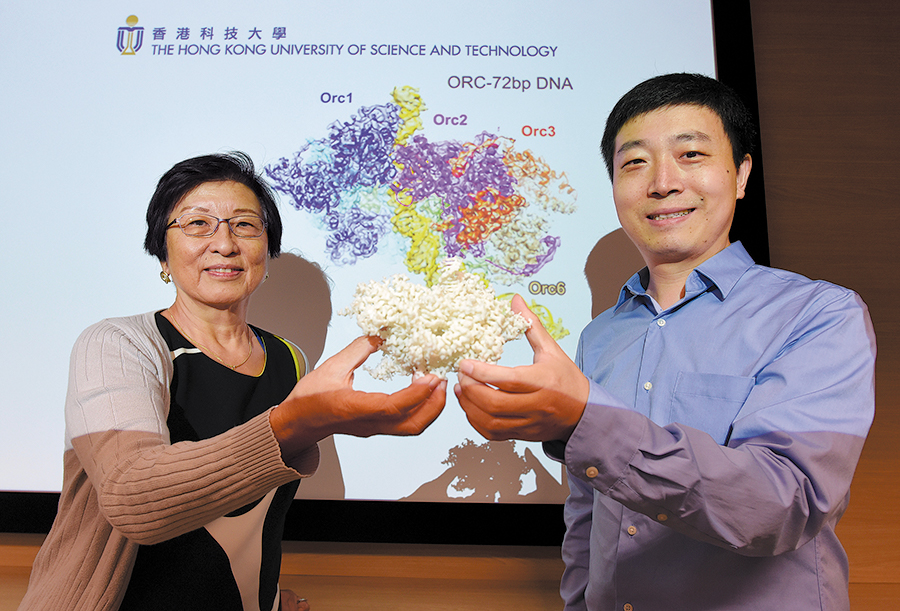
In 1953, James Watson and Francis Crick discovered the double helix structure of DNA, opening up endless possibilities for exploring the genome and genetics. For over 70 years, biologists around the world have ceaselessly researched DNA, attempting to unravel the mysteries of life at the microscopic level.
Professor Zhai Yuanliang from the School of Biological Sciences at the University of Hong Kong is one of them. At age 45, he has devoted nearly half of his life to studying the molecular mechanisms of DNA replication.
On Jan 5 last year, Zhai and his collaborators revealed a mechanism for the regulation of DNA replication by MCM(minichromosome maintenance) proteins in the top international scientific journal Cell. This research was selected as one of the top 10 scientific advancements in China last year, and Zhai's team was the only Hong Kong-based research team included on the list.
However, the journey to achieve this research breakthrough was filled with decades of twists and turns.
"People generally think that DNA replication is an old field, but this is actually a misconception," Zhai said.
Due to the low resolution of previous instruments, it used to be impossible to clearly observe the microscopic structures. Even though the double helix structure of DNA was discovered as early as 1953, how it unwinds and opens has always been a mystery.
In 2004, Zhai began researching the mechanism of DNA replication during his doctoral studies at the Hong Kong University of Science and Technology, where he spent every day in the lab observing the process of DNA replication, continuously proposing new structural models and repeatedly verifying them. This routine has persisted for 20 years.
But despite his dedication, progress was slow for Zhai.
"In scientific research, one must have persistence," said Zhai.
The pace was so slow in fact, that his first paper was only accepted one month before graduation after six years of PhD study.
"The pressure at that time was really immense. I thought if I couldn't graduate, I might quit scientific research," he said.
Zhai explained that in around 2010 in the field of life sciences, neuroscience and brain science were considered the frontiers of biological research. Due to technological limitations, many believed that it was difficult to make essential breakthroughs in the field of DNA replication. Consequently, many people switched to other fields.
However, he was obsessed with the intricacies of the microscopic world and couldn't free himself from it. "When you look inside a cell, you will find it amazing because it is truly beautiful," Zhai said.
With this passion, in 2011, Zhai continued his postdoctoral studies in the field of DNA replication under the supervision of Bik-Kwoon Tye, who was a professor at Cornell University in the United States and a visiting professor at HKUST.

Compared to the doctoral program, the postdoctoral program had a higher requirement for research achievements. However, Zhai's research path was still not smooth sailing, and by around 2014, he still hadn't published any research papers.
"Not publishing any papers during the four-year postdoctoral program brings a lot of pressure," he said.
But that all changed thanks to technological innovation. In 2013, the advent of cryo-electron microscopy propelled DNA research to a new level.
Zhai explained that cryo-electron microscopy has a very high resolution, enabling the observation of structures that were previously unseen such as what is at the core of DNA replication — the MCM protein.
DNA is a double-stranded helix that carries genetic information. Within living organisms, DNA needs to be unwound by enzymes, followed by replication, or transcription, to achieve the transmission and expression of genetic traits.
The MCM protein is an enzyme responsible for unwinding the DNA double helix during the DNA replication process, and regulates the initiation of DNA replication.
Zhai said that the instability of the human genome is generally considered a crucial factor in triggering cancer, and the MCM protein, as a DNA helicase at the initiation of DNA replication, regulates genome duplication. Studying the mechanism of the MCM protein is of significant importance for the development of anticancer drugs.
Persistence in his first decade of research led to a windfall in the next. With technological innovation, Zhai soon experienced the "spring" of his research path.
In 2015, one of his papers was published in the international scientific journal Nature, and in 2017, he published two papers in top journals Natural Structural and Molecular Biology, and Molecular Cell, followed by another paper in Nature in 2018. In the same year, he joined the University of Hong Kong as a principal investigator, continuing his research path.
"I dare not say that I am very capable, but as long as I persist, I can seize opportunities when they arise," he said.
On March 6, Zhai and his team published their latest findings in Nature. It was the first time internationally that high-resolution details of the recycling process of parental histones within the framework of DNA replication had been demonstrated.
"Today, our research capabilities in the field of DNA replication are at the forefront of the world," Zhai said.
When asked about what advancements he expects in the future, he said: "Now, with technological innovation, the threshold for structural biology is not as high as before. I look forward to more people being able to conduct the best scientific research, driving the progress of science and fostering the prosperous development of the entire scientific research ecosystem."
















